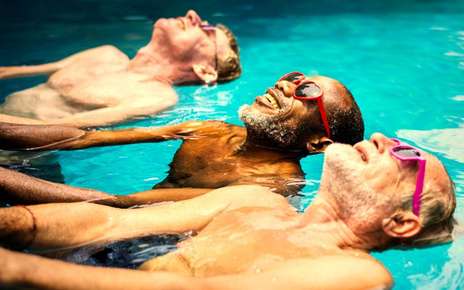
Summer Sports
In the summertime, everyone's thoughts turn to the outdoors. We want to get out in the sun and have some fun. Some people do exercise outdoors, such as running, walking, and biking, all year long regardless of the weather.1 For others, summer's warmer temperatures make activity outside the house or the gym more inviting, and tennis courts, basketball courts, soccer fields, and baseball diamonds become filled with younger and older athletes, all looking to bounce, hit, or kick a ball around with their friends and opponents. Other summer activities include surfing and rollerblading, and although these activities may also be done year round, many people prefer to get their boarding and blading in when temperatures are subjectively more conducive.
Summer sports provide substantial personal satisfaction as well as health and wellness benefits. Any exercise, after all, is good exercise. But exercise needs to be done in context. For example, if you haven't done any type of exercise since last summer, attempting to play three sets of tennis your first time on the court will likely lead to trouble, specifically, a strained muscle, sprained ligament, or worse. Similarly, trying to run up and down a basketball court or trying to leap to snag a sharp line drive during a baseball game may cause an immediate problem if you are out of condition.
The best course of action is to re-engage in summer sports slowly, a little at a time.2 Even better, of course, is to participate in a consistent program of regular vigorous exercise throughout the year. Federal and healthcare professional guidelines recommend doing at least 30 minutes of vigorous exercise five days a week. Engaging in an ideal program of cardiovascular exercise, strength training, and core exercise on a weekly basis provides a level of fitness that supports all types of summer sports.
Here’s why:
Strength training enables your body to bear heavy loads throughout full ranges of motion of various joint structures such as the ankle, knee, hip, and lower back.
Cardiovascular exercise increases the amount of blood your heart pumps on each beat and trains your lungs to take in more air on each breath.
Core exercises enhance your body's ability to support loads under suddenly changing three-dimensional forces such as twisting, pivoting, bending, and lifting.3
Regular chiropractic care supports all of your exercise and sporting activities, in addition to strengthening your immune system and optimizing the functioning of your nerve system, your body's master system. By detecting, analyzing, and correcting spinal misalignments and other sources of nerve irritation, regular chiropractic care helps ensure that you and your family will enjoy a summer filled with enjoyable activities. As well, regular chiropractic care helps ensure long-term health and wellness for you and your family throughout the year.
1Bezerra P, et al: The influence of winter and summer seasons on physical fitness in aged population. Arch Gerontol Geriatr 76:80-84, 2018
2Evans EW, et al: Promoting health and activity in the summer trial: Implementation and outcomes of a pilot study. Prev Med Rep 10:87-92, 2018
3Coulombe BJ, et al: Core Stability Exercise Versus General Exercise for Chronic Low Back Pain. J Athl Train 52(1):71-72, 2017
